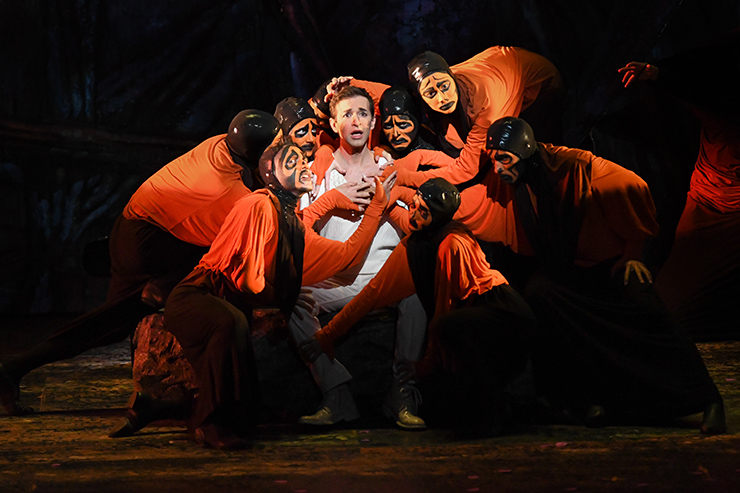
Anthony Roth Constanzo and UnderWorld Cast - Photo By Chris Kakol
It remains a wonder why Johann Sebastian Bach never wrote an opera. The man who literally transformed the musical vocabulary of Western music, creating the tools for every serious future composer to come, didn’t try his hand at the grand form, the operatic underpinnings of which had already been mined by countless Baroque composers including Monteverdi, Scarlatti, Vivaldi, and of course, Handel.
Beginning around 1600, the new grand entertainment, at first attempting to breathe new life into the Greek drama (Hark! I hear a Greek chorus), sputtered into view, producing a bunch of Baroque “strike a pose and sing” formulaic spectacles about gods and heroes, most of which have not survived the popular repertoire.
Then came Gluck, straddling the Baroque and Classical periods, unapologetically establishing reforms that put story over music, inspiring the likes of Mozart and Wagner… and the rest is operatic history.
Having cut his musical teeth in the early 18th century during the time of opera seria, dominated by inflated singing and display rather than convincing drama, Gluck started pushing back with reforms that advanced the story. Gluck was out to abandon style that broke up the action for a more flowing and dramatic bent; he made a sharp left turn away from the hallmarks of seria to create a through-composed work. Now action drove the music, creating a fully integrated drama where music served plot. (Rodgers and Hammerstein would later do the same with the “book driven musical,” displacing early 20th century shows where plot existed only to launch another song and dance, significantly reshaping the Broadway musical scene.)
Gluck’s reforms are evident in his spin on the myth of Orpheus, the musician and poet who journeyed to the underworld to rescue his recently deceased wife, Eurydice. Dramatic effect was elevated over music and overblown vocal melodies became Humanized; the seamlessly integrated sung text contained arias that arose naturally from their dramatic surroundings, supported by simple harmonies and a more robust orchestra. Of the over 40 operas penned by Gluck, “Orfeo ed Euridice” remains at the top of his list.
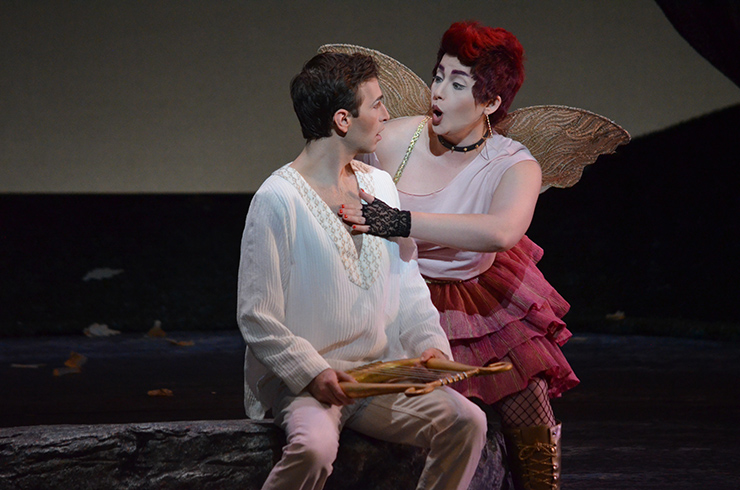
Photo by Chris Kakol
One tradition Gluck did maintain was the use of castrati – the singing sensations resulting from the castration of young boys. Already commonplace in Italian Renaissance churches, as females were banned from singing there, castrato was the voice of choice for leading male roles in Italian Baroque opera. European opera houses (with the exception of French venues) favored the voice of the castrati and composers of the day wrote specifically for that voice type. When the practice of using castrati fell out of favor in the 19th century, Giulio Cesare, Orfeo and other leading characters became “pants” or “trouser” roles, the gender bending theatrical tradition where a female actor or singer appeared in male clothing to play a male character. With a castratolike range, it became customary to use contraltos or mezzo-sopranos for these leads. The renewed interest in Baroque operas in the latter half of the 20th century has attracted countertenors (a male singer whose vocal range is similar to that of a mezzo-soprano) to credibly play these characters.
FGO has embraced Baroque opera in recent years, using countertenors in Handel’s “Giulio Cesare” and Monteverdi’s “The Coronation of Poppaea.” And now Gluck’s “Orfeo ed Euridice” is being played out on the FGO stage, employing both casting traditions – countertenor Anthony Roth Costanzo and mezzo-soprano Lindsay Amman sharing the role of Orfeo.
Actually, the character of Orpheus, the son of the muse of music, famously having the ability to charm all things, even the rocks and trees, is a fine vehicle for a countertenor, as his voice, like Costanzo’s, was enchanting.
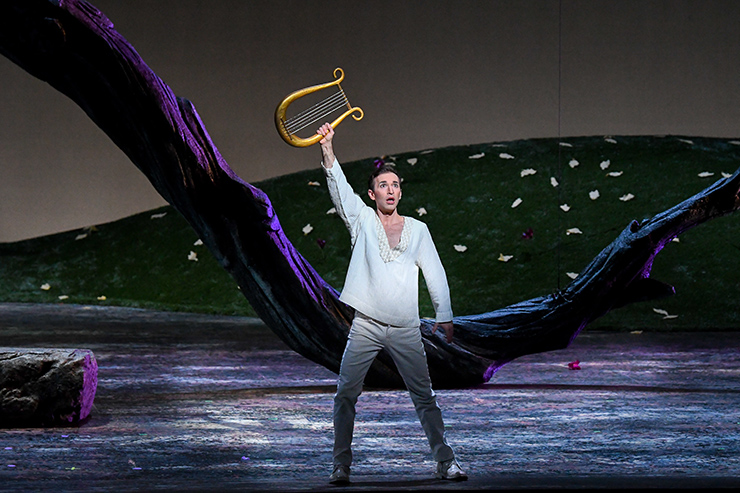
Anthony Roth Costanzo - Photo By Chris Kakol
Gluck’s overture was crafted in a markedly Classical style, maestro Anthony Barrese and the FGO orchestra nimbly rendering it as Keturah Stickann’s shrewd stage direction, with frolicking couples foreshadowing the later scene in Elysium, played out Euridice’s death by snake bite, filling in the backstory which is not addressed in the libretto.
Costanzo quickly established his character and vocal strength upon his entrance into his wife’s tomb with cries of “Euridice,” his vocal clarity and power distinct and commanding in the single name.
In Orfeo’s lamenting aria, “Chiamo il mio ben cosi,” Costanzo’s remarkable unforced voice, through a series of transitions from melancholy to resolve, hit his high notes with precision and strength and, just as quickly, pulled back with tender emotion, reaching his lower notes with the same level of control and character.
His is a distinctively male voice imbued with a mezzo’s tessitura. As he began to summon the gods for help, Costanzo inhabited his considerable upper register in a soul-searching moment that was indeed divine.
Though a high-pitched voice for our hero may have thrown some audience members off at first, at no time do you question Costanzo’s ardor for Euridice.
In an intense scene where Orfeo, determined to enter Hades, implored the Furies to take pity on him, Costanzo physicalized to his words, then pushed back on the creepy Goddesses of Vengeance. Heidi Zamora’s Furies costumes bound the slimy creature’s arms inside tube-like getups.
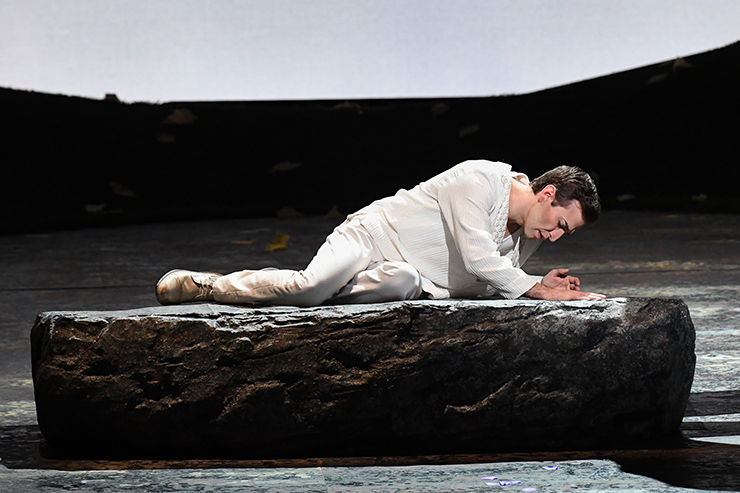
Anthony Roth Constanzo - Photo by Chris Kakol
With lyre in hand (a running harp in the pit underscoring the lyrics like a steady motor), Orfeo goes to work, begging for pity (“Deh placatevi con me”), the Furies resisting with shouts of “No!” But Costanzo’s resonant voice was steady as he continued to stand firm against the creatures. On his knees (amidst the spooky red shadows by lighting designer Lucas Krech), Costanzo’s lulling voice finally soothed the Furies into submission (“Mille pene”), Orfeo having endured “a thousand pains.” He stood, picking up the tempo (“Men tiranne voi sareste”), finally sweetly convincing the Furies to let him enter Hades.
Costanzo stunningly attacked a single note softly, raised the volume on it, and went quiet again, all in one seamless breath, often adding a flawless fluttering tremolo for riveting emotional effect.
Gluck created several orchestral phases of grief as the countertenor finessed the melodious and heartbreaking showstopper, “Che farò senza Euridice,” vocally crossing the lines of despair and loss with hypnotic emotion. Costanzo, grabbing a note of enormous purity, raised the volume, then instantly sent it down to his chest voice to implore his now dead-again wife to “answer me!” Declaring “there is no more help for me in heaven or on earth,” Costanzo’s rich round tones of uncanny tenderness and conviction prompted the audience to erupt with whistles and bravoes.
Picking flowers in Elysium and singing of how “the burdens of the soul die away,” soprano Jessica E. Jones (Euridice), essayed the aria “È quest'asilo ameno e grato” with splendid voice. Her acting chops were spot on, honestly conflicted while playing both delight and confusion when Orfeo refused to look at her (a fate that would send her back to the land of the dead). Riddled with the pain of a character dealing with the possibility of “dying a second time,” Jones passionately navigated the multi-tempoed “Che fiero momento,” declaring that she would “rather die than lose his love,” playing her transitions both vocally and physically with a full ranged quality that beautifully evoked the sadness and resolve of the aria.
Costanzo and Jones blended their voices with great effect on the duet "Vieni, appaga il tuo consorte," acquitting well the individual torment of their characters, Orfeo suffering in silence and Euridice confronting him as to why he won’t face her, their harmonies profound in their simplicity.
Playing Amor (Cupid) was soprano Evan Kardon, a spritely redhead, her character complete with golden knee-high boots and a pair of sparkly golden wings. Kardon’s lilting and lovely voice was a treat as she swept across the stage, giving Orfeo a golden lyre and encouraging him to rescue his wife from the underworld with the dance-tempoed “Gli sguardi trattieni Amor,” assuring him that his suffering would be short-lived.
Barrese and the first-rate FGO orchestra transported us with the pleasant instrumental to the Elysian Fields and skillfully underscored Stickann’s nifty choreography for the ballet sequence where the nymphs and Furies battled over Orfeo’s lyre.
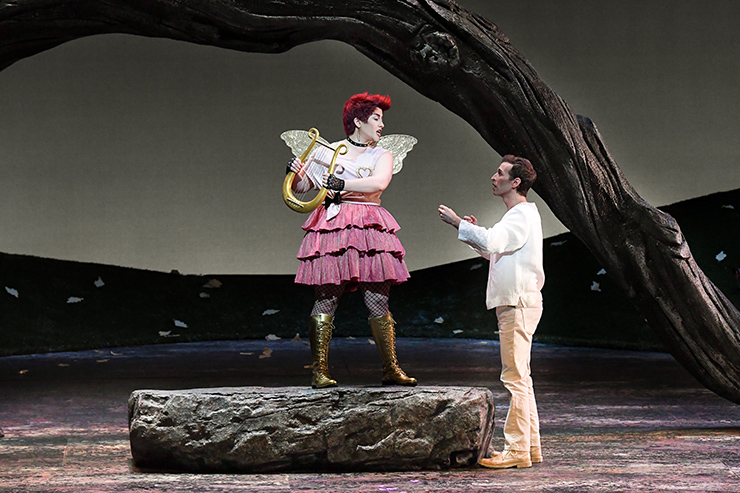
Evan Kardon and Anthony Roth Constanzo - Photo by Chris Kakol
The full-bodied chorus, the fourth character, was well-rehearsed by chorus master Katherine Kozak, the shepherds and shepherdesses creating a big solemn sound during Euridice’s funeral with "Ah, se intorno.” After Orfeo’s arioso “Che puro ciel,” musing on the beauty and peacefulness of Elysium, the chorus of spirits, agreeing to bring Euridice to him, blended their high and low voices with precisioned calm in "Torna, o bella," maximizing Gluck’s intentional simple and heavenly harmonies. Voices filled the hall with "Trionfi Amore," Amor having revived Euridice and prevented Orfeo from dispatching himself. Love triumphed!
Costanzo lifted the lyre over his head and the crowd favored the production with a hearty standing O.
Phillip Lienau’s minimal raked stage boasted two tiny hillocks and for the Hades descent, painted backdrops showing tangles of tree roots, gave the illusion of being deep in the earth.
This is the first time Gluck’s great work has been presented on the FGO stage in its 77-year history, and credit must go to FGO general director, Susan T. Danis for helming the production. Danis has been striving to build more robust FGO seasons, going beyond the masterpieces to include new works and something for the operatic enthusiast. The 2018-2019 season is reflective of her vision: “La bohème,” “The Marriage of Figaro,” “Frida” and “Werther.”
Orfeo ed EuridiceBy Christoph Willibald Gluck; libretto by Ranieri de' Calzabigi; conductor, Anthony Barrese; stage director, Keturah Stickann; choreographer, Keturah Stickann; dancers, Dimensions Dance Theater of Miami; production, Seattle Opera; sets by Phillip Lienau; lighting by Lucas Krech; costumes by Heidi Zamora; wig and make-up by Sue Schaefer; chorus master, Katherine Kozak; assistant conductor, Joshua Horsch; production stage manager, Liam Roche; FGO general director, Susan T. Danis
CAST: Orfeo - Anthony Roth Costanzo (March 17, 20, 24, 29, 31) and Lindsay Ammann (March 18 & 23), Euridice - Jessica E. Jones, Amor - Evan Kardon
Remaining schedule | Orfeo ed Euridice
Sung without amplification in Italian with projected titles in English and Spanish.
Miami Adrienne Arsht Center / Ziff Ballet Opera House
Friday, March 23 at 8 p.m.
Saturday, March 24 at 8 p.m.Fort Lauderdale / Broward Center for the Performing Arts’ Au-Rene Theater
Thursday, March 29 at 7:30 p.m.
Saturday, March 31 at 7:30 p.m.Audio Description provided by the Arsht Audio Description Volunteer Team is available without charge for blind and visually impaired patrons attending Arsht Center operas and Broadway shows.
Ticket purchases can be made online at www.FGO.org or by phone at FGO’s Box Office (800) 740-1010.
 MAIN MENU
MAIN MENU

